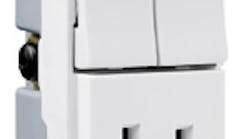Engineers and product managers from Pass & Seymour/Legrand (P&S) traveled across the country to visit vintage homes in Atlanta, Baltimore, Boston, and San Francisco, meet with contractors and homeowners, and learn how to build a better combination device. And after spending more than a year on research and development, the Syracuse, N.Y.-based company launched its line of TradeMaster Decorator Combination Devices in March 2003.
P&S's line of single-gang combination devices allows electricians to install multiple switches within a single existing box during a kitchen or bathroom remodeling project. The products are available in 16 possible combinations, including devices with two switches and a receptacle, four single-pole switches, and a nightlight with a receptacle. Todd Childers, vice president of Atlanta-based Childers Electric, says about half of his firm's work comes from residential renovation and remodeling projects, and when his electricians work on older homes, they have a limited amount of space to install devices.
“On existing installations, the wiring is already in place,” Childers says. “Rather than tearing out sheetrock and installing multi-switches, you can use what's there and install the combination devices. It saves us at least 75% in labor.”
By identifying a need for an expanded line of combination devices in the market, P&S was not only able to help contractors offer a variety of solutions to their customers, but also captured the Platinum Award in EC&M's 2004 Product of the Year competition. A panel of 10 electrical professionals, including engineers, electricians, and plant facility personnel, first narrowed the field of competitors from more than 100 entries to finalists in 21 product categories. EC&M readers then voted for their favorite product on EC&M's Web site. When the votes were tallied, the line of combination devices came out on top.
EC&M presented P&S with the Product of the Year Platinum Award following the opening keynote presentation at the Electric 2004 show on May 25 in Indianapolis. Yann Kulp, product manager for residential devices and plates for P&S, says the devices were designed with many features to make them easier for contractors to install and more convenient for the homeowners. For example, the devices feature screw-pressure-plate back wiring terminals, which are the preferred method of termination in the remodeling industry, Kulp says.
“It's better than a standard screw because you don't have to loop the wire, which can be tough and time consuming if you're using 12-gauge wire,” Kulp says. “By using a pressure plate, the contractor knows that his termination is rock solid, which means he won't have call backs or loose terminations.”
Since P&S first introduced toggle versions of the products 10 or 15 years ago, Kulp says that kitchens and bathrooms have evolved. At that time, a typical bathroom had two lights or a light and a fan. Today homeowners keep asking contractors to install more devices. To handle these increased loads, some of the combination devices feature a split circuit tab, which allows contractors to put more loads and higher power loads into the same device. Bob Twichell, owner of Fayetteville, N.Y.-based RLT Electric, says both the pressure plate and split circuit tab ease the installation process.
“If you run into an application where two circuits might be coming into one box and controlling different things, you can pull a tab and split the circuit,” Twichell says. “You can then use the wires that are coming back into the box without having to do any extra wiring.”
The combination devices also feature up/down switching rather than sideways switching to make it more convenient for homeowners, who are often accustomed to flipping a switch vertically rather than horizontally. Contractors can designate the main switch for frequently used applications like vanity lights and the smaller switches for secondary applications like fans or heat lamps. To make it even easier for homeowners, P&S designed a snap-in lighting module to illuminate the devices so they can be found in the middle of the night. Contractors can add the lighting feature to any of the devices by removing a plastic tab from the top and bottom and snapping in the light module to create the connection.
“In one second, a contractor can transform a standard device into an illuminated device,” Kulp says. “Instead of having to carry a different part number, the contractor has regular devices in his truck and a handful of these modules. It's very convenient for a contractor and easy to execute.”
Through continued research and development, P&S is expanding the line to include products that meet contractors' needs in a changing marketplace. Twichell says the P&S team meets with his local contractors association to share product designs, listen to the contractors' views on the products, and then make revisions. Since he first saw the product designs at a monthly association meeting, Twichell says he's installed between 50 and 60 combination devices and keeps extras in his truck to save time if he's out on a job.
“The whole line of combination devices is designed for contractor convenience,” Twichell says.
Main Features
- Up/down switches
- Oversized main switch
- Snap-in light module
- Fully rounded back body
- Impact-resistant face and body
- Ground screw position under the end of the strap
- Full wraparound metal strap with lock-in tabs
- Tri-drive screws
- Split circuit tab that can be reinstalled without a tool
- External screw pressure plate back that accepts 12 AWG and 14 AWG conductor
- Devices are available in black to match appliances
- Circuitry is identified on the backbody with raised lettering




